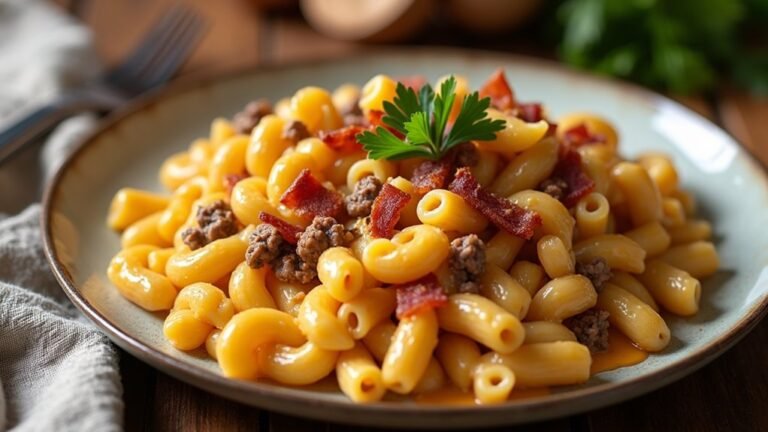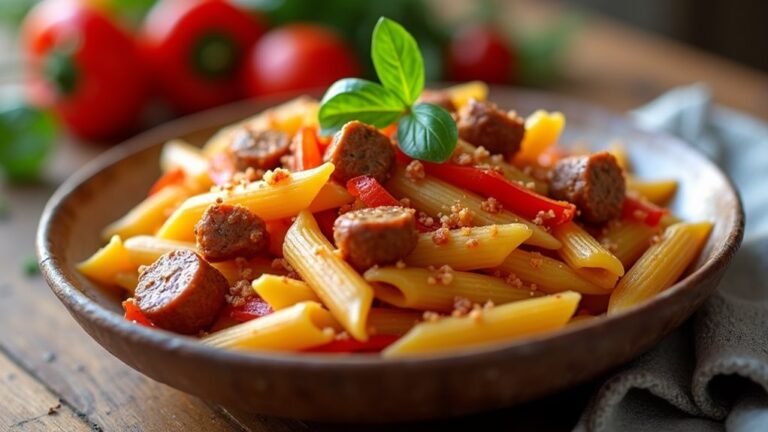Spaghetti Carbonara Recipe: Classic Italian Comfort
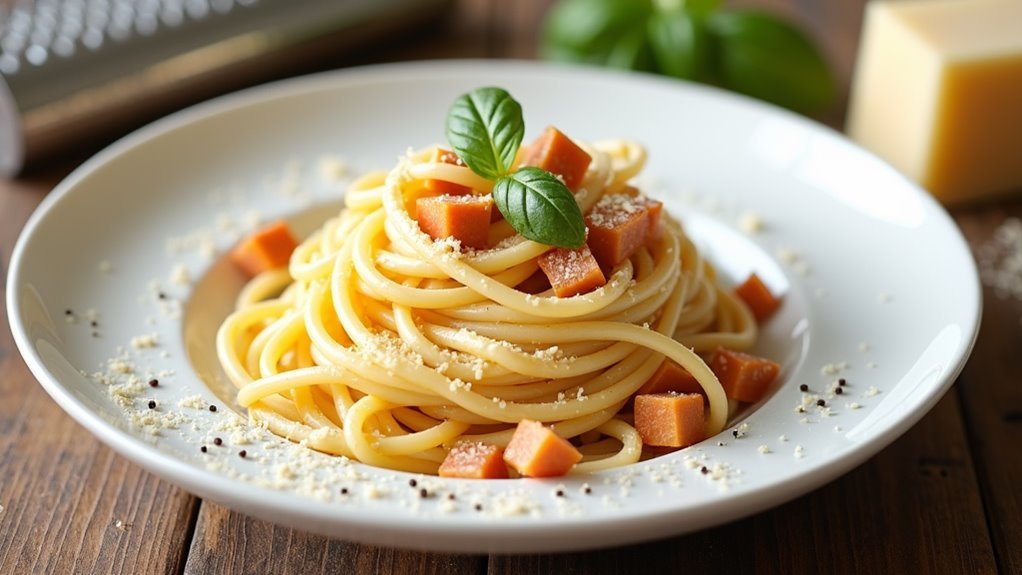
Creating an authentic Spaghetti Carbonara is simpler than you might expect. With quality ingredients like guanciale and Pecorino Romano, you can capture the essence of Italian comfort. The key lies in timing and technique—mixing freshly cooked pasta with an egg mixture for a creamy texture. Let's explore the nuances that make this dish a kitchen staple worldwide.
Key Takeaways
- Classic Italian dish from Rome featuring a creamy sauce made without cream.
- Traditional ingredients include spaghetti, guanciale, Pecorino Romano, and black pepper.
- Key technique involves using pasta heat to cook the egg and cheese mixture.
- Cook guanciale until crispy, then combine with pasta and egg mixture off direct heat.
- Serve immediately for optimal flavor, using reserved pasta water to adjust sauce consistency.
Recipe
Spaghetti Carbonara is a classic Italian dish that hails from the heart of Rome. Known for its simplicity and rich flavor, this dish relies on just a few high-quality ingredients to create a creamy sauce without the use of cream. The key to achieving the perfect carbonara is in the technique, where the heat from the pasta delicately cooks the egg mixture, resulting in a silky, luxurious finish.
Traditionally, this dish is made with guanciale, a type of cured pork, but pancetta can be used as a substitute if guanciale is unavailable.
The essence of an authentic carbonara lies in its balance of flavors and textures. The savory, slightly salty taste of the cured pork complements the sharpness of Pecorino Romano cheese, while freshly ground black pepper adds a subtle spice. The eggs bring everything together, creating a creamy coating that clings to each strand of spaghetti.
With proper temperature control and a bit of practice, you can transform these simple ingredients into an unforgettable dish.
Ingredients:
- 1 pound spaghetti
- 4 large eggs
- 8 ounces guanciale or pancetta
- 1 cup freshly grated Pecorino Romano cheese
- Freshly ground black pepper
To make Spaghetti Carbonara, start by bringing a large pot of salted water to a boil and cook the spaghetti according to package instructions.
While the pasta is cooking, cut the guanciale into small cubes and cook them in a pan until they're crispy. In a separate bowl, whisk together the eggs and Pecorino Romano cheese.
Once the pasta is al dente, reserve 1 cup of pasta water and drain the rest. Quickly add the hot pasta to the pan with the guanciale, remove the pan from direct heat, and pour in the egg mixture. Toss the pasta rapidly to coat it evenly and create a creamy sauce, adding reserved pasta water as needed to reach the desired consistency.
Extra Tips: Temperature control is crucial in making carbonara. Ensure that the pasta is hot enough to cook the eggs into a creamy sauce but not so hot that they scramble.
Always remove the pan from direct heat before adding the egg mixture to prevent scrambling. If the sauce becomes too thick, add small amounts of reserved pasta water while stirring to achieve the right consistency.
Serve immediately to enjoy the dish at its creamiest and most flavorful.
Cooking Steps
You're about to bring the flavors of Rome right into your kitchen, starting with boiling a big pot of salted water for your spaghetti, so get ready for some serious Italian magic!
While the pasta cooks, let the guanciale sizzle until it's irresistibly crispy, and whisk those eggs with cheese for a rich, creamy delight.
With everything prepped, combine your hot pasta with the crispy guanciale, then quickly toss it all together with the egg mixture to create the perfect, velvety sauce.
Step 1. Boil Salted Water
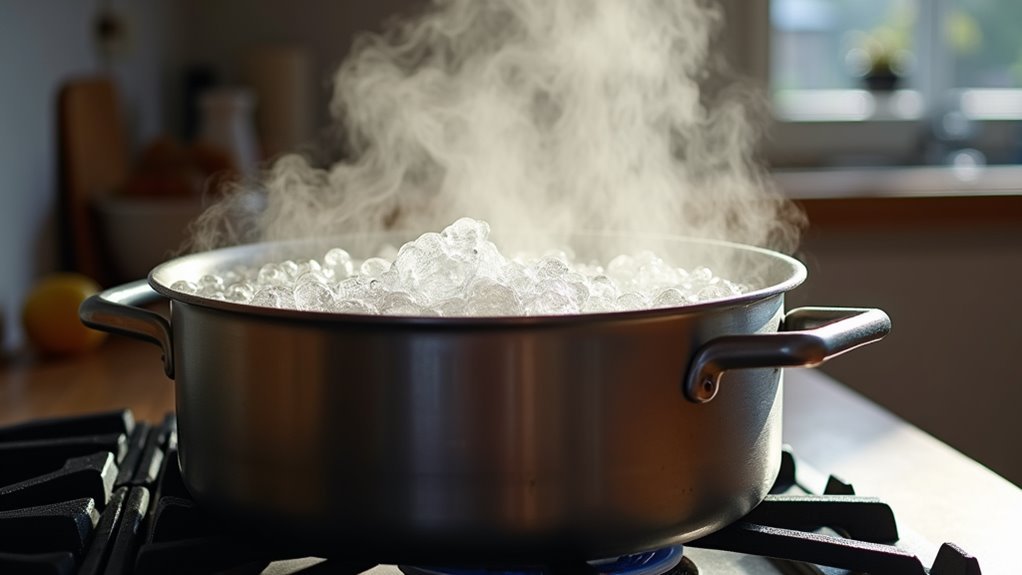
Starting with the essentials, bring a large pot of salted water to a rolling boil. This step lays the foundation for perfect spaghetti carbonara, so don't skimp on the salt—think of it as seasoning the pasta from the inside out.
As the water heats, you'll feel the anticipation build, knowing that each step brings you closer to a delightful Italian meal. The salt enhances the pasta's natural flavor, making every bite more enjoyable.
Use enough water to give the pasta space to move freely and cook evenly. Once the water reaches a furious boil, it's time to add the spaghetti, letting it dance in the bubbling water.
Your kitchen will soon be filled with the promise of a classic, comforting dish.
Step 2. Cook Guanciale Until Crispy
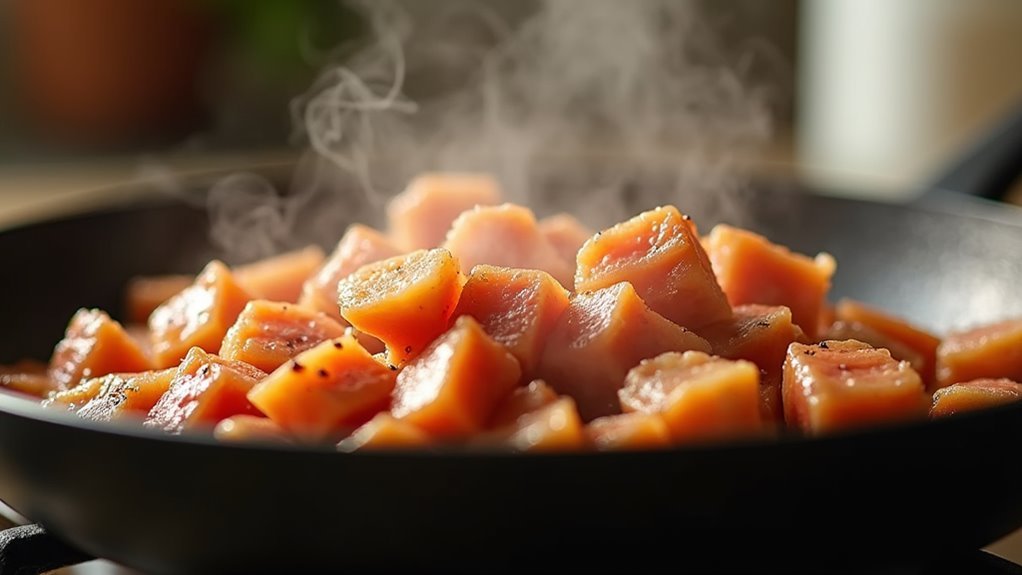
As the pasta cooks, turn your attention to the guanciale, which is essential for that rich, savory flavor in your carbonara.
Begin by cutting the guanciale into small cubes, ensuring each piece is roughly the same size for even cooking.
Place the cubes in a cold pan, then set it over medium heat. This allows the fat to slowly render out, turning each piece golden and crispy.
Stir occasionally, keeping an eye out for that perfect crunch. The aroma will fill your kitchen, teasing your taste buds with promises of the delicious dish to come.
Once crispy, remove the pan from the heat.
Step 3. Whisk Eggs With Cheese
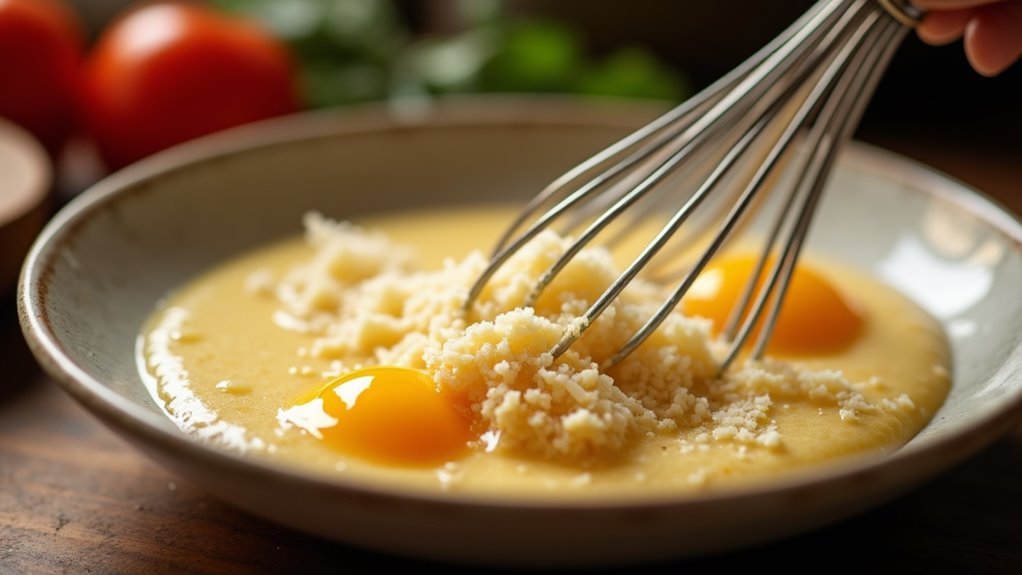
To craft the perfect carbonara sauce, begin by whisking the eggs and cheese together until smooth and well combined. Use a medium-sized bowl, cracking in four large eggs, and add a cup of freshly grated Pecorino Romano cheese.
Whisk vigorously, ensuring the mixture becomes creamy and uniform. Don't hold back—this step is key to achieving that luscious, velvety sauce carbonara is famous for. As you whisk, feel the excitement build, knowing you're about to create something truly special.
The cheese should meld seamlessly with the eggs, creating a rich base that will cling to the spaghetti. This simple yet essential step infuses your dish with authentic Italian flavor.
With your egg mixture ready, you're one step closer to carbonara perfection!
Step 4. Combine Pasta With Guanciale

With your egg and cheese mixture ready, it's time to focus on the pasta and guanciale.
Start by cutting the guanciale into small cubes and bring them to life in a hot pan, letting them sizzle until they're perfectly crispy and aromatic.
While the guanciale is cooking, ensure your spaghetti is boiled to al dente perfection, following the package instructions.
Don't forget to reserve that precious cup of pasta water before draining!
Once the pasta is ready, quickly add it to the pan with the guanciale, letting the flavors meld beautifully.
Stir everything together, ensuring each strand of spaghetti is kissed by the flavorful guanciale.
This step sets the stage for the creamy magic that's about to unfold!
Step 5. Toss Pasta With Egg Mixture

Swiftly transition from the guanciale-infused pasta to the creamy magic by introducing the egg mixture.
You've got to move quickly here! Drain your al dente spaghetti, reserving some of that precious pasta water. Toss the steaming pasta into the pan with the crispy guanciale, and take it off the heat.
Now, pour in the egg and cheese mixture, letting the residual warmth transform it into a velvety sauce. Stir energetically to ensure every strand is coated. If the sauce feels too thick, add a bit of reserved pasta water until it's just right.
Let the aroma fill your kitchen as you finish with freshly ground black pepper. Your masterpiece is ready—serve immediately for the best creamy texture!
Final Thoughts
Creating a perfect Carbonara is an art that combines simplicity with technique. You've mastered the balance of creamy sauce, salty guanciale, and perfectly cooked pasta.
Enjoying this classic dish is like experiencing a cozy Italian evening right at your table. Remember, the beauty of Carbonara lies in its rich flavors and the satisfaction of creating a meal from just a few ingredients.
Don't be intimidated by the process; practice makes perfect. Each time you cook, you'll refine your skills and confidence.
Invite friends or family to share in the joy of your culinary creation. They'll appreciate the delicious effort and love you've put into the dish.
Now, you're ready to savor your masterpiece and embrace the warmth of Italian comfort food.
Frequently Asked Questions
Can I Use Bacon Instead of Guanciale or Pancetta?
Absolutely, you can use bacon instead of guanciale or pancetta!
Bacon's smoky flavor adds a unique twist to your carbonara. Just make sure to cook it until crispy, capturing that delightful crunch.
Remember, balance is key: balance the saltiness, balance the creaminess, balance the flavors.
As you whisk the eggs and cheese, and toss with hot pasta, you'll create an indulgent sauce that'll impress anyone.
Dive in, and enjoy your creation!
How Can I Prevent the Eggs From Scrambling?
To prevent the eggs from scrambling in your carbonara, remove the pan from heat before adding the egg mixture.
Toss the pasta vigorously to coat it evenly. The key is in the timing—ensure the pasta's hot enough to cook the eggs gently without scrambling them.
If the sauce thickens too much, don't worry! Just add a splash of reserved pasta water and keep tossing.
You'll achieve that creamy perfection in no time!
What's the Best Pasta Shape for Carbonara?
You'll want to use spaghetti for carbonara; it's the traditional choice and works perfectly! The long strands hold the creamy sauce beautifully, ensuring each bite is simply divine.
Plus, spaghetti's smooth texture allows the guanciale or pancetta to cling to it, creating flavor bursts in every forkful.
When you toss the pasta with the egg and cheese mixture, it evenly coats the strands, resulting in a luxurious, velvety masterpiece.
Enjoy!
Can Carbonara Be Made Vegetarian?
Absolutely, you can make carbonara vegetarian! Imagine a delicious dinner where you swap guanciale with sautéed mushrooms or zucchini.
These veggies add a hearty texture and rich flavor. Just cook them until tender, then mix with your pasta.
When you toss in the egg and cheese mixture, watch it turn into a creamy, dreamy sauce. You'll love the satisfying blend of flavors, all while keeping it meat-free.
Give it a try!
Is It Possible to Reheat Leftover Carbonara?
Yes, you can reheat leftover carbonara, and it's easier than you think!
Start by adding a splash of water or chicken broth to the pasta to prevent it from drying out. Gently reheat it in a pan over low heat, stirring frequently. Avoid using high heat to keep the sauce creamy instead of scrambled.
Alternatively, you can use a microwave, stirring every 30 seconds until warmed through.
Enjoy your delicious leftovers!



